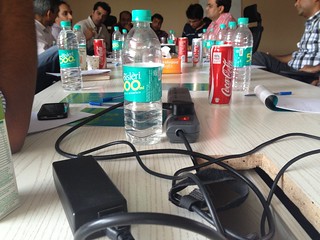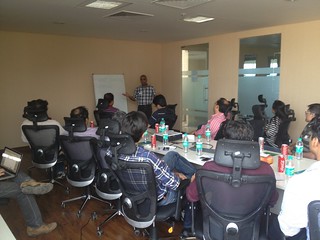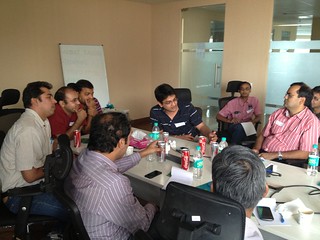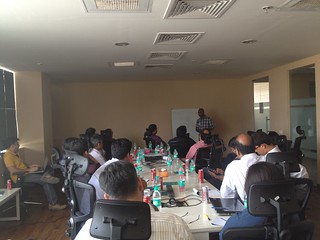When nearly two dozen product enthusiasts sit around a table passionately talking for 4-½ hours, expertly addressed by two product veterans – Amit Somani and Amit Ranjan, you can expect an information overload. And, it did seem like drinking from the firehose, trying to capture all the takeaways in the intense back and forth, where even a tea-break seemed imposed. A blast it was – this iSPIRT Playbook Roundtable Delhi edition on “Effective Product Mgmt & Delivery”, focused around learning for startups.
[This was the NCR session on Apr 13th. Initiated, as part of iSPIRT, by Avinash Raghava, and very ably facilitated & supported by Aneesh Reddy. Great facility and great Food by Eko Financials. Thanks guys, Awesome effort!!!]

Thankfully, there was a structure, laid out initially across specific dimensions – Product Planning, Delivering, Hiring, Culture, Metrics, Customer. These themes kept repeating through the session with questions coming from participants across the breadth & depth of product management, and many times touching upon all the aspects of running a product company.
Here’s an attempt to sum up the takeaways from this long & exhaustive (not exhausting, yet!) session.
Planning & Delivering the Product
– Product Planning in many start-ups is not an elaborate exercise. It is typically handled by one of the founders, and “build and adapt as you go” is the norm.
– Delivering a great product is always an intersection of Engineering, Design and Product Management, with Product team in the driver’s seat. This intersection and collaboration is one of the critical factors in getting a great product delivered.
– Getting the Engineers and Designers to collaborate is one of the key challenges. As per Amit R, what helped them at Slideshare was the fact that they always hired Engineers with a flair for Design. A great developer as part of the product team is 70% Engineer & 30% Designer, as per him.
Product Metrics
Amit S emphasized that metrics are very important for product managers. When the team grows (when you can no longer rely on people to just talk to each other and get things done), the metrics-driven product management becomes critical. Touching upon the right hiring in this context, Amit S insists on covering the candidate’s thought process around metrics (with open questions such as – what would be your primary metric if you were designing the Delhi metro).
Metrics & the Rule of 1/1/1: This is one rule around metric that Amit S follows. What will be your metric for 1 Week, 1 Month, & 1 Year. Break it down, with crystal clarity and follow it up religiously. (A great resource for B2C space around metrics is a presentation by Dave McCleor – Startup Metrics for Pirates).
Some learning around Metrics:
– It is important to be clear of the vision, and how it connects to the primary metrics that you define. There’s a direct correspondence between identification of the key metric and the clarity of what the product is trying to achieve.
– Relevance of the metrics to the specific goals through the product journey is important. As one goes along in the product journey, the dimensions on which key metrics are identified may vary. Initially it may be customer acquisition; And then it may be engagement; then conversion; retention; life-time value; and so on.
Customers
One of the key questions around customer aspect of product management is – What is the right spec for the product? One of the biggest mistakes product managers tend to make, as per Amit S, is when they confuse the “Customer Requirements” with the “Product Requirements”! Sorting this out is the core to the responsibility of a Product Manager.
Some of the tips & tricks around Product Specs:
– When faced with a requirement, the first pass criterion (in B2B scenario) should be – if the requirement is relevant to at least 3 customers.
– There are various tools to interact with customers, and get feedback: Surveys, Net Promoter Scoring, Feedback through the product interfaces, and so on.
– Get the Information from Customers, Tone it down, Tune it further, and then arrive at the specs for “Engineering”.
– What should the spec typically look like? Default Rule of Thumb – 1 Page Spec. It should be very focused, very clear, in what the feature is trying to achieve, and at the same time not too long.
– A Good quality spec considers the “Least Granularity of time” with Clarity of thought. That’s from the Project Management perspective. From the functional perspective, Amazon has a good model that can be followed. Every Spec at Amazon is a 6-Pager Document – forcing people to establish clarity of thought and articulation.
– Another good alternative is the 1 Pager “Lean Canvas” by Al Ries.
– Equally important is to figure out Non-Goals – “What is not in Spec”? What are the features you need to remove! (Cue Reference: Joel Spolsky on Functional Specifications and an example Functional Spec.)
– It’s also important to be clear on “What” requires a spec and What doesn’t. Both at Slideshare and MakeMyTrip, the team goes through multiple “Lights-on” stuff that they need to perform to keep the business running on routine basis. And these are fast-track enhancements and modifications driven by immediate business needs and marketing requirements. The Lights-on requirements are different from Core Functional Specs for the product roadmap.
– Another criteria that decides how detailed the spec should be is based on the number of users getting impacted.
– How do you handle customer requests with investment requirements that are not justifiable on the ROI? There are multiple considerations to this. The “Life-time Value” of the customer is important, and if such investments allow you to enhance it and calculate ROI in longer term benefits, it may still work well. There are alternative ways to look at this though. In the experience of Aneesh at Capillary, they had divergent requests that led to a very different direction for the Product and transformed it from “Mobile CRM” to “Intelligent CRM”. Another possibility could be to look at partner ecosystem and see if there’s a synergetic way to address these needs.
– How do you manage your customer requirements into “Not to have” features? How do you single out the noise? While it is nice to think of an ideal situation of getting the product requirements at the planning stage, when the customers use the product, they often come back with plenty of views that need to be funneled down. When you have to discard some requirements, it is important to “talk to a lot of people” to ensure weight. Also, some of the requirements die-down on their own, clearly indicating noise factor. It is a balancing exercise between reducing the hassles in customer feedback process and creating enough friction to dampen the noisy “Vocal Minority” (the term that Amit R uses to refer to the few customers that may be so noisy that their voice seems more important than is worthwhile for the product).
Hiring and Product Management Structure
As per Amit R, Product Managers should be (are!) Second-in-command in the sense that they decide the future of the company. Considering this, it is critical that one single product dimension doesn’t overweigh the hiring process. So, intake process for Product Managers needs to follow the 70% rule – The Product Managers need to be aware on all the broader and holistic dimensions of running the product business including sales, marketing, operations, design, and so on, with 30% depth on the critical Product Management areas.
Some of the specific tips on this from Amit S and Amit R, and some from participants:
– Determine if the candidate can think holistically and de-clutter the thought process in the crowded set of inputs. Ability to deal with ambiguity.
– Product management is typically a “common-sensical” thing. Look for common sense and intuitive angle.
– A great product manager would do well on what can be referred bluntly as “dhandha” (Money part of the busines). You cannot afford to have a Great product with “no” money.
– One of the participant companies built their structure around Customer Success. Majority of the Product roadmap is driven by the Customer Operations, Tickets, and resolutions – and driven by how customers used and viewed the product in B2B scenario. In such cases, they typically found it useful to move folks from Customer Success team into the Product Management areas.
– In case of another successful participant company, the CTO is playing the role of Product Manager and it is working very well for them.
On the relationship between the CEO/Founder and Product Managers. As per Amit S, Product Manager is the CEO of the Product, while the CEO is (of course) the CEO of the Business. One of the challenges for the Founders is how quickly they are able to let go he Product Management and start focusing on the business and Product metrics. Amit R also emphasized that it can work cleanly with the CEO focusing on the business aspects while Product Manager focused on the Product aspects while maintaining the alignment.
Where should the Product Manager Report? At high level one case say that it depends on where you are in the evolution of the product/company, and what the Product really means to the vision of the company. However, over time, Product Management needs to be separated from Marketing and Engineering. In essence, Product Manager shouldn’t report to the Engineering or Sales or Marketing. In corollary, there should not be a reporting into Product Manager as well. Product Manager is a “Glue” job, and is key to a healthy tension for the product direction.
Product Manager is WHAT of the Product – Defines what (functionally) should be built. Engineering is HOW and WHEN of the Product – Details out & manages “How” (technically) and “When” (schedule-wise) should the stuff be built.
One needs to also establish clarity on Product Management being different from typical Project Management. Also, there are strategic aspects of product that are owned by the executive management, however, you always need a “Champion” of the product that is independent of the other forces that drive the organization.
Importance of Data Guy! Another structural aspect that Amit R emphasized on (multiple times!) was the importance of a “Data” person in the Product Team. This role is almost as important as a Product Manager in the sense that Data & Analytics can play a key role in the product Roadmap definition. There are various flavors of the Data – Dashboards and reporting, Product Management level Metrics, Decision Science, for instance. Interesting to note is the fact that at LinkedIn, next set of products are heavily influenced by “Decision Scientists”. (Cue References: Hal R Varian, Chief Economist at Google and DJ Patil)
While there was a whole lot of structure to these discussions, we had some extremely valuable side discussions that link back to the Product Management, and very important to address. Here are some! 🙂
Positioning. For a clear direction for Product Management, the positioning of the product in the market is a key factor. How do you refer to the product? The answer to this question, in case of start-ups, seemed unanimous that the start-ups are too limited in resources/focus/energy to be able to create a new category. Aligning to an existing category with a differentiator is the key to early success. For instance, Slideshare referred to itself as “Youtube of presentations”, Vatika positioned itself as Parachute with Additional ingredients, “Busy” positioned itself as Tally with better inventory management and statutory reporting.
(Positioning is an important theme and comes with lot of related broader areas for considerations for Product Companies. We will have a round-table specifically around Positioning in near term)
What’s a Product? (A rudimentary question, I know! But worthwhile to hear the perspectives! J) How do you differentiate functional Product Management from the technical side of it? As per Amit R, “Product is the core experience or core touch-point for your end-consumers with your business.” It is worthwhile to note that the various types of customers may have different ways to access the product and there may be different ways to define the touch-points for every segment. For instance, Slideshare follows a Freemium model where 5% of the Paying customers may have a different set of touch-point experience from the rest of 95% free users. So various segments, such as Free B2C, Paying B2C, Paying B2B, and Partner B2B may all have different touch points with the same Product.
How do you get the Product Managers to champion the cause of usability and aesthetics? As per Amit R, in case of Slideshare, CEO happens to be from the usability background and that helped a great deal, since the thought process permeates across. It is important to engrain the usability in the way of the product management, since you cannot bolt it later, as per Amit S. There are various ways MakeMyTrip tries to do that. One of the eureka moments, for instance, for Engineers and developers was when they were shown a “live session” of a user through the Screen capture tool. It also helps to have the live user sessions in front of the product team. Some of these approaches can build that appreciation for the user actions in the minds of product team, over time with sustained effort.
Retention and Customer Lock-in: Slideshare has learned the harder way that ignoring Emails as a mechanism for customer engagement and retention is costly. LinkedIn relies on Email based “Customer retention” and “Returning Users”. Jeevansathi.com uses a strategy to map the customers in various life-stages and uses various Email and SMS templates to engage them even through the very short life-time of 3-4 months.
The Mobile Storm: As per Amit S, having a Mobile Strategy through this year and next year is critical for the product companies. Web is no more the only option, and for some products, it is becoming a mere secondary. Mobile First makes sense. The transactional figures for Mobile are increasing at such a rapid pace, that an afterthought based Mobile based functionality may not work so well.
If this is any indication of the things to come, the product ecosystem will benefit immensely from the initiative. Looking forward to the furutre editions, and share more!
Please share your views!








